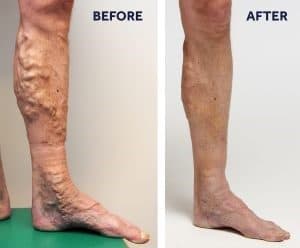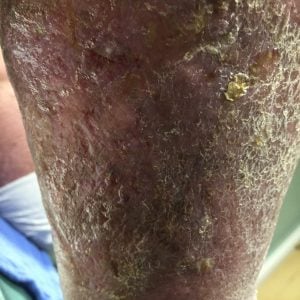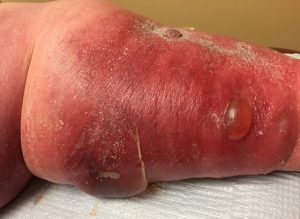Men’s Vein Specialists

DR. TIMOTHY KAVIC, M.D., F.A.C.S.
Our accomplished team of doctors and technicians at the Advanced Vein Center have over 60 combined years of experience treating varicose veins. Dr Kavic is also the Director of the Cosmetic Professionals at Body Beautiful Laser Medical Spa, where spider veins are treated by a variety of methods, including sclerotherapy, Laser services, compression therapy and VNUS Closure.

DR. MAURICIO GIRALDO, M.D.
Is a skilled, board-certified surgeon with remarkable experience and multiple awards of distinction including Distinguished Best Student of Internal Medicine.
As an instructor of Surgery at Harvard Medical School, he has trained many skilled physicians and played a vital role in shaping their professional lives. Dr. Giraldo did a General Surgery Residency at AGH and a three-year fellowship at UPMC in Transplant Surgery. He is a member of the American Society for Laser Medicine and Surgery. He is certified in the VNUS Closure Procedure.
Venous Insufficiency – Venous Reflux
Venous insufficiency is the inability of the veins in the leg to pump the blood back up to the heart. This is generally caused by damage or a weakening of the valves in the veins. You see, our veins have one-way valves in them to keep all of the blood flowing in the proper direction. These valves ensure that oxygen-rich blood reaches every part of your body and, once depleted of oxygen, makes the journey back to the lungs and heart to start its journey anew. When the venous valves do not work correctly, blood will pool in the legs and can cause a number of symptoms ranging from unpleasant to debilitating. If left untreated, pooling will lead to:
- Bleeding – sometimes uncontrollable,
- “Dark leg” – a dark discoloration of the legs,
- Pain in the leg – pulsing or sharp pains,
- Scarring of the skin – scars left behind from sores,
- Swelling – ranging from mild to debilitating and
- Ulcers – open sores that are difficult to treat
Get rid of your varicose veins permanently with modern, minimally invasive procedures.

While varicose veins can (and do) appear anywhere on the body the overwhelming majority are found on the legs. Even when they appear elsewhere, for example, on the forearm, they usually don’t cause any physical symptoms. Those found on the legs, however, can cause symptoms ranging from minor achiness to open, non-healing ulcers. In short, almost all varicose veins which require treatment are located on the legs.
If you’re among the tens of millions of Americans whose veins are bad enough to treat you’ve most likely tried compression stockings. These specialty garments apply constant pressure to the legs and thighs in order to help force blood upwards. While this conservative approach may provide symptomatic relief it won’t solve your underlying problem. Also, while stockings may prevent additional veins from forming they can’t stop the disease process from progressing. For most patients, wearing compression garments is only delaying the inevitable.
If you’re interested in solving your vein problem permanently there’s never been a better time to take action. Older procedures, namely vein stripping, are rapidly being replaced with much less invasive options. These treatments have already helped tens of thousands of patients find relief from problems exactly like yours. What’s more, in many cases your health insurance will cover the price of the procedure.
The benefits of venous ablation.
Prior to venous ablation, vein stripping surgery was the only reliable method of treating chronic venous reflux. This was a highly invasive procedure that often involved a 7 to 10-day hospital stay. Long, prominent scars were also common. Now, even though several effective, minimally invasive treatments are available many primary care physicians remain unaware of these options.
This is unfortunate since many of these doctors won’t recommend reflux treatment because they regard vein stripping as simply not worth the risk. The patients are, in effect, being told to “just put up with it.” Such patients are invariably prescribed traditional compression therapy which frequently achieves mediocre results.
“Ulcer patients almost always see a primary care physician first. Then, most of the time, they’re told to use compression therapy indefinitely.” This, according to Chief Physician Allan Dunn of London Imperial College, is usually where treatment stops. “Frequently they are not referred to a vascular specialist for evaluation. It’s a shame, and it’s not doing right by the patients.”
While the early intervention trial is a single study it does indicates that compression alone isn’t enough. Says Dunn, “even without the study everyone knows this. It intuitively makes sense. But many physicians are slow to change and haven’t gotten on board. Whenever possible we treat with endovenous ablation, and the earlier the better. Patients heal faster, in over 25 years of practice I’ve seen this many, many times.”
Have you been dealing with venous ulcers for weeks, months, or even years? If so, it’s time to ask yourself if what you’re doing is really working. Call The Advanced Vein Center at our Cranberry, Butler, or Bridgewater locations today at (724) 987-3220 to explore your options. Most major medical plans are accepted.
What’s the cost of the average minimally invasive procedure?
This will depend on several factors, the most obvious being the type of procedure involved. In terms of insurance coverage however there’s really only one question—is the procedure “medically necessary?” We’ll discuss this concept further, but first, let’s review the basics.
What exactly are varicose veins, and what causes them?
Your body’s veins have a single yet very important “job” upon which the health of every cell in your body depends. When working properly, veins conduct all of your blood, from every part of your body, towards the heart. Once there, the heart pumps the blood back out through your arteries, and the cycle begins again. In essence, your arteries are the “outgoing” half of your circulatory system while your veins are the “incoming” half.
This isn’t to say that your veins will work properly all of the time. Over time, conditions such as obesity, multiple pregnancies, and prolonged inactivity have the potential to damage your body’s veins. There appears to be a strong genetic component as well. This damage usually takes the form of your veins becoming stretched out. When this happens the valves within your veins become leaky resulting in what’s known as “venous reflux.” This refers to a partial backflow of blood back down the leg which ultimately causes almost all vein disease.
4 indications that you may need to see a vein specialist.
If you’re experiencing the uncomfortable, painful symptoms associated with varicose veins you’re not alone. Venous reflux, also known as Chronic Venous Insufficiency (CVI), is the root cause of this condition. Statistically speaking it will affect about 40% of the adult population in America at some point in their lives. Fortunately, today this condition is very treatable.
This isn’t to say that many people make the connection between varicose veins and their other symptoms. If you’ve had any of the following for a month or more it’s highly likely that your situation won’t improve on its own. At this point, it’s best to consult a vein specialist for a correct diagnosis and effective treatment.
1) Swelling in your legs and ankles—especially at the end of the day.
After being on your feet all day it’s normal for your legs to feel tired. If, on the other hand, your ankles regularly swell then you may have a problem. This is almost always a sign that blood is pooling in your legs due to underlying vein disease.
Other common symptoms include achiness, throbbing, cramping, itching, burning, and Restless Leg Syndrome (RLS). If any of the above describe how your legs feel on an ongoing basis then it’s time to seek medical treatment.
2) Skin changes of the lower legs and ankles.

Chronic venous reflux results in an increased pressure inside the veins of the legs. This added pressure can lead to impaired circulation which often affects the skin. If you’ve noticed that your skin has become brown, reddish, or leathery this is the most likely cause. Crusting or scaling of the affected skin is also common.
Symptoms such as these usually indicate moderate to severe vein disease. It’s possible for these symptoms of Spider Veins Treatment Men to remain stable for years. In reality, however, there’s a good chance that they’ll gradually worsen without proper treatment.
3) Open ulcers on the ankles and lower parts of the leg.

These are almost always the result of severe and persistent venous disease. As with the Spider Veins Treatment and skin changes mentioned above, these are a direct result of reduced blood flow.
Non-healing or slow healing ulcers are widely regarded as the most severe consequence of untreated vein disease. For starters, they’re quite unsightly. More importantly, they can be quite painful, with some patients rating the pain at 8 or 9 out of 10. It’s also possible for dangerous infections to occur which in extreme cases may necessitate amputation.
4) Bulging veins in the pelvic region.
In most circumstances ropey, knotted varicose veins are found on the thighs, legs, and ankles. This being said it’s not uncommon for such veins to appear on the buttocks or genitals. Pregnant women are particularly vulnerable due to the pressure put on the pelvis by the developing baby. More often than not this condition is very uncomfortable and is accompanied by intense feelings of pressure and throbbing. In most cases, varicose veins of the genitals will improve after the baby is delivered yet worsen with additional pregnancies.
In all of the above cases, it’s a good idea to seek the help of a vein specialist. This is particularly true when ulcers or less severe skin changes occur. Modern treatments are minimally invasive, and in many cases will resolve your symptoms entirely. If you’ve been dealing with chronic vein issues there’s no reason to keep suffering. Take the first step today and call The Advanced Vein Center at (724) 987-3220 to book an appointment.
Should men ignore varicose veins treatment?
It is generally not advisable to ignore varicose veins treatment, regardless of gender, as they can potentially lead to complications if left untreated.
Varicose veins may worsen over time and can cause symptoms such as pain, aching, throbbing, swelling, and fatigue in the legs. They can also cause skin changes, such as darkening, inflammation, and ulceration, which may require medical attention. Additionally, varicose veins can be a cosmetic concern for some individuals, affecting their self-esteem and quality of life.
Moreover, varicose veins can be a sign of an underlying venous insufficiency, a condition where the veins’ valves are not functioning properly, leading to blood pooling and increased pressure in the veins. Venous insufficiency can potentially lead to more serious complications, such as deep vein thrombosis (DVT) or venous ulcers, if left untreated.
Fortunately, there are various treatment options available for varicose veins, including lifestyle changes, compression stockings, minimally invasive procedures, and surgical interventions, depending on the severity and symptoms. Seeking medical evaluation by a qualified healthcare professional can help determine the appropriate treatment approach based on an individual’s specific condition and overall health.
What are the signs you need to look for a treatment for varicose veins?
If you are experiencing any of the following signs, it may be an indication to seek treatment for varicose veins:
Pain or discomfort: Varicose veins can cause pain or discomfort in the legs, ranging from a dull ache to a throbbing or burning sensation. The pain may worsen after prolonged periods of standing or sitting and may affect your daily activities.
Visible swelling or bulging veins: Varicose veins are often visible as twisted, enlarged veins that may appear blue or purple in color. They may protrude or bulge from the surface of the skin and can be cosmetically bothersome.
So, if you’re a man with varicose veins, you are not alone and you can do something about it.
Six Tips For Men With Varicose Veins
1. The impact of Varicose Veins is Deeper Than Just the Skin
The first thing that many of us think of when we hear of varicose veins, is the impact that it has on one’s appearance. Most of the time, treatment for varicose veins is only done to correct a cosmetic issue. This, in fact, may be why many men don’t have their varicose veins treated; because they simply aren’t concerned with the appearance of the veins or they are in less conspicuous areas. The truth, however, is that leaving varicose veins untreated can be quite serious. For a better understanding as to why, we should review what varicose veins actually are.
When veins are healthy, they pump blood back up to your heart and you don’t even think about them. However, when not doing their job properly, the blood can pool or stick in sections of the veins. Healthy veins can quickly turn from a fully-functioning and automated part of the circulatory system to painful, twisted, and swollen blood vessels.
Regardless of the level of pain you feel, varicose veins are a warning sign that the blood flow to your heart is restricted. Restricted blood flow will most frequently occur in your legs but varicose veins can appear anywhere and can be a serious medical problem. If varicose veins remain untreated, they can cause pain, swelling, and possibly even skin ulcerations.
2. You are not Alone
Varicose veins affect approximately 30 million Americans at any given time, making it a very common medical issue. This does not make the seriousness of the condition any less significant, but it should be of some comfort to know that a large number of men and women bring up the topic to their healthcare providers every year. You do not need to feel embarrassed or reluctant to talk about your condition to your physician. In fact, the prevalence of varicose veins is a plus when it comes to treatment. Since so many suffer from varicose veins, there has been a lot of research and breakthroughs regarding their treatment. Treatment protocols are established and effective.
3. It’s Time to Get Moving
Scheduling a consultation with a vein specialist is the first important step in determining the severity of your varicose veins. Varicose veins will not go away on their own however, the healthcare professional that you see will likely suggest a few lifestyle changes to help in reducing the intensity and the number of varicose veins. By changing your daily habits, you may be able to help prevent new varicose veins from popping up. The following have been identified as risk factors for developing varicose veins:
- being overweight,
- advancing age
- genetics
- hormones
- sitting or standing for too long
We can’t do much about our genes, hormones, or age but there are steps you can take to address the other risk factors. By taking up a mild exercise routine, you can address both your weight and the amount of time you spend sitting, thus helping your varicose veins. You don’t need to become a marathon runner or triathlete, but if you can commit to working out for 30 minutes a day, it will make a huge difference in your weight, reducing the pressure you’re putting on your veins and your time spent being sedentary.
There are some simple ways to start exercising in a way that addresses your varicose veins:

- biking (or Bicycle Legs)
- using an elliptical machine
- leg exercises (leg and knee lifts)
- walking
- jogging
- rocking on your feet
- lunges
The more extra poundage you carry around with you and the more time you spend in one position (either sitting or standing means) puts more pressure on your veins. This is what causes the veins to become damaged in the first place, turning into varicose veins.
Preparing for your Procedure
Time will be set aside to discuss your medical history and complete a physical exam. At this time, we will go over all of the details with you to insure that you have a positive outcome. You will receive paperwork at the end of your consultation.
There are a few precautions you should take before coming into the office for laser treatment.
Do’s
- Wear loose and comfortable clothing
Dont’s
- Sunbathe, use tanning beds or have the area waxed for at least two weeks prior to the procedure.
- Take aspirin, anti-inflammatory drugs or any herbal supplements (increased bleeding risk).
- Smoke for two weeks prior to the procedure.
- Drink any alcohol for 48 hours.
The vast majority of procedures used to treat spider veins are quick and painless, however, they may not be a perfect, permanent fix.
Can you prevent varicose veins?
Varicose vein prevention measures include:
maintaining a healthy weight.
doing regular exercise
raising your feet while seated
keeping your legs straight while seated
not dressing constrictively
The Procedure
The procedure can be completed in a doctor’s office or medical clinic and usually only lasts 10 to 15 minutes. In most cases, two (2) to four (4) treatments several weeks apart are required for the procedure to be completely effective. It is normal for the skin above the veins to become red for a couple of days following the procedure. It may take several months for the veins to completely disappear.
How does stress or anxiety influence varicose veins in men?
Stress and anxiety can indirectly influence varicose veins in men through several mechanisms:
1. Blood Pressure: Stress and anxiety can increase blood pressure, which can put additional strain on the veins and contribute to the development or worsening of varicose veins.
2. Blood Flow: Stress and anxiety can lead to changes in blood flow patterns, potentially affecting the function of veins and valves. This can contribute to the development of varicose veins or exacerbate existing ones.
3. Inflammation: Chronic stress and anxiety can lead to inflammation in the body, which may affect the health of the veins and increase the risk of varicose veins.
4. Lifestyle Factors: Stress and anxiety can also influence lifestyle factors such as diet, exercise, and sleep, which can indirectly impact vein health and contribute to varicose veins.
Are there any specific skincare practices that can benefit men with varicose veins?
Yes, there are several skincare practices that can benefit men with varicose veins:
1. Moisturizing: Keeping the skin well-hydrated can help prevent dryness and itching, which can be common with varicose veins.
2. Gentle Cleansing: Using a mild, non-irritating cleanser can help keep the skin clean without stripping it of its natural oils.
3. Avoiding Harsh Products: Avoiding harsh chemicals or exfoliants can help prevent irritation and damage to the skin.
4. Sun Protection: Protecting the skin from sun damage with sunscreen or protective clothing can help prevent skin discoloration and other issues associated with varicose veins.
Can varicose veins in men be prevented?
Varicose veins in men can be prevented or minimized by maintaining a healthy lifestyle. This includes regular exercise to improve circulation, maintaining a healthy weight, avoiding prolonged standing or sitting, wearing compression stockings if recommended, and elevating the legs when resting. Healthy dietary choices and avoiding smoking also contribute to
prevention.
